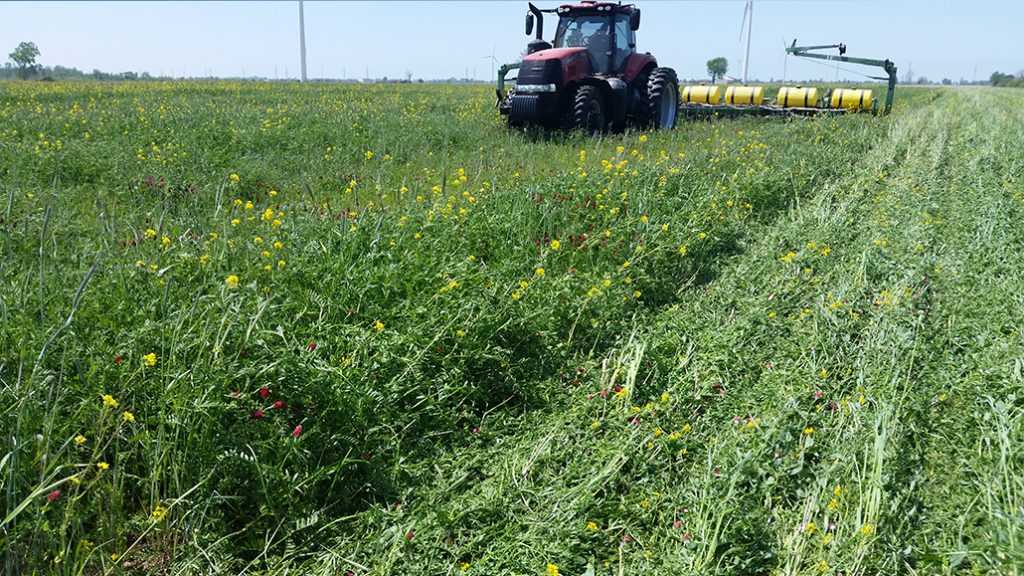Cover crop basics
IDENTIFYING SPECIFIC GOALS

SOIL ORGANIC MATTER decline in cropland continues to be a significant issue across much of Ontario. The problem is particularly acute in the deep Southwest, where a lack of forage and manure fertilizer — a result of dwindling livestock herds — reduces the opportunity to apply organic inputs.
Cover cropping, however, is an excellent way to reverse this trend and rehabilitate soil health. With a little thought, incorporating cover crops in standard rotation schedules can be an excellent investment in environmental and business sustainability.
START SLOW
Jake Munroe, field crop soil fertility specialist for the Ontario Ministry of Agriculture, Food and Rural Affairs, says those interested in cover crops should start slow. This is because the challenge of managing more intensive cover crop systems — and particularly those with overwintering species — can be significant.
Farmers, he says, might want to start with one or a simple mixture of cover crops. These can be seeded after winter wheat, and could include oats, peas, or radish; such plants do not overwinter, and are thus easier to manage in the spring.
Ultimately, the cover crop used is determined by the farmer’s goals. If generating a nitrogen credit is the focus, Munroe says legumes are the best option. Reducing erosion might require species that provide more winter cover. Reducing compaction could start with species that produce deep taproots or fibrous root systems — radish and cereal rye for example.
Those with greater cover crop experience, he says, may want to add more species, such as sunflowers, warm-season grasses like sorghum-sudangrass, or alternative legumes such as hairy vetch. They may also include species that can successfully overwinter, though he reiterates the importance of having a clear management plan for spring growth.
“For those who have success with underseeded red clover in winter wheat, it is still an excellent cover crop that can be killed in the fall or spring,” says Munroe.
EQUIPMENT AND TECH
Blake Vince, a Merlin-area grain farmer who has been incorporating multi-species cover crop mixtures in a no-till system since 2011, encourages others to start by experimenting on a portion of their wheat acres. He adds that even intensive, overwintering cover crop systems — such as his 18-specie mixture designed to mimic the diversity of wild plants — can be largely managed by modifying one’s pre-existing equipment rather than spending considerable cash on something new.
“We are really starting to see the system come to life in terms of the resilience of our crops in subsequent crop years,” says Vince. “We’ve seen a proliferation of beneficial insects; we have slugs like everyone else, but most times it’s not an issue because of all those beneficial insects […] There’s been an increase in rare or endangered species like the bobolink and meadowlark.”
Vince also says the decomposition rate in his fields has skyrocketed, meaning a much higher level of microbial activity. He also says he’s seen noticeable improvements in water and nutrient uptake, and carbon sequestering.
Mark Richards, a grain, sugar beet, and tomato farmer from Dresden, also actively plants cover crops with modified equipment (a 12-row strip-till machine augmented with a variable-rate fertilizer wagon) to prepare rows for planting the next crop. The effectiveness of this equipment is augmented with GPS and Real-Time Kinetic (RTK) technology.
“We run everything on GPS and auto-steer except the sprayer. We use RTK there […] it’s reducing labour with tech know-how,” says Richards. “One of the biggest reasons we are using cover crops is to decrease [herbicide] resistant weed pressures. They seem to make the herbicide more effective on what’s left as well.”
While soil organic matter levels across their fields have not jumped, he says, there also hasn’t been a decline despite harvesting higher yields.
TERMINATION
Ensuring proper termination is a critical part of managing both single-specie and multi-specie cover crops. Where cover may overwinter, terminating in autumn or early spring can eliminate residue and self-inflicted weed pressures — where cover crops become cover weeds — during spring planting.
“I like to spray early,” says Henry Denotter, a Kingsville-area grain farmer who actively incorporates cover crops into his rotation.
In his experience, Denotter says one of the most significant issues with growing cover crops in his Brookston Clay soil is getting the ground uniformly dry and warm prior to spring planting. He’s tried applying herbicide to green cover early in the fall as well as later in spring. The former, he says, was the most effective way to ensure good soil conditions at planting time.
Denotter also says they had particular success following oats and buckwheat — usually applied at a light 10 pounds per acre — with just glyphosate at burn-down. Since glyphosate doesn’t leave a residue, he is not restricted in what he can plant afterwards.
“If you leave oats and it goes to seed it’s a real challenge to get the ground dried out in spring,” he says.
Kris McNaughton, research associate at the University of Guelph Ridgetown Campus, also says early burndown in either season is an effective way to reduce planting issues for most green cover. However, she says the desired level of residue in some cover crops are more easily attained than others — provided the right herbicide or herbicide mixture is used.
Cereal ryegrass, for example, can be easily killed with a mid-rate dose of Roundup (approximately 1.3 litres per acre); because it’s easy to kill, she says growers can more easily determine how much residue they want — based in part on what their planter can handle.
For red clover, McNaughton says a natural tolerance to glyphosate — something common among legumes — means it should be approached with tank mixes containing Banvel, 2 4-D, or other group four herbicides. Eragon can also be used, though is less preferable in her experience.
However, McNaughton says persistent and hard-to-kill plants like annual ryegrass should be avoided. This is because it’s very difficult to achieve near-complete control even with high rates of diverse herbicide mixtures, meaning resistance issues are a much more significant concern.
“Use a high rate of Roundup, about two litres per acre, plus a group one herbicide like Assure or Select,” says McNaughton regarding annual ryegrass. “Kill it early. Doing it in the fall is best but then there’s no biomass, so you have to ask yourself what you’re really doing it for […] You can use it for other jobs, but not as overwinter cover.”
McNaughton adds that covering plants that survive into the second year are much harder to kill, so sometimes a second herbicide application is required. Tillage is also an option.
Regardless, McNaughton reiterates that cover crops are a valuable part of one’s crop rotation.
“Make sure you kill it early. Make sure you’re using the right herbicide at the right rate,” she says. “Talk to the people in your area who are using cover crops. They can give you tips. You don’t need to do it alone.”
For more information on cover crops, watch the GrainTALK webinar ‘Cover crop management and decisions’ available at www.gfo.ca/GrainTALK. •





















